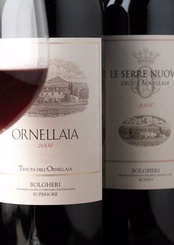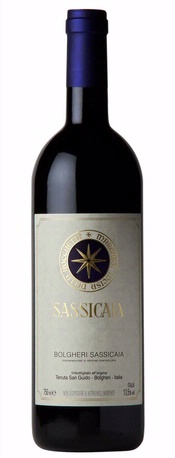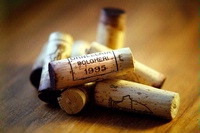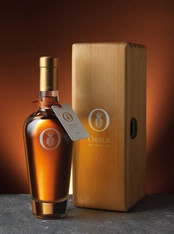About 35 years ago, a new category of Italian red wines emerged in Tuscany. Chianti was selling poorly in the 1970s, primarily because it was being over-produced, with many of the wines coming from inferior vineyard sites. As a result of the then-poor reputation of Chianti, some producers began making wines that diverged from the DOC wine regulations for Chianti. Some made wines that were 100 percent Sangiovese; even more made blended wines, using Cabernet Sauvignon,  Merlot, and other varieties, with or without Sangiovese in the blends. These wines were typically more expensive than Chianti wines; they began to be called “Super-Tuscan” wines.
Merlot, and other varieties, with or without Sangiovese in the blends. These wines were typically more expensive than Chianti wines; they began to be called “Super-Tuscan” wines.
The first so-called Super-Tuscan wine–and still one of the best–was Sassicaia, made by Tenuta San Guido, a mainly Cabernet Sauvignon wine, with some Cabernet Franc (now a DOC wine, by the way). It comes from vineyards in a warmer area of Tuscany, the Bolgheri Coast. In the Chianti Classico zone, Piero Antinori jumped on the Super-Tuscan bandwagon early with his Tignanello (80 percent Sangiovese, 20 percent Cabernet Sauvignon), and later, Solaia (80 percent Cabernet Sauvignon, 20 percent Sangiovese).
After a few years, almost every major Tuscan producer was making its version of a Super-Tuscan wine. The wines were well received by critics, and soon, they became the most sought-after Italian cult wines. At first, they were categorized as simple Vino da Tavola (table wine), but that didn’t matter to consumers. In 1992, these wines segued into a new category, Indicazione Geografica Tipica, known as IGT. Some Super-Tuscan wines, like Sassicaia, now have their own DOC appellation (Sassicaia’s is Bolgheri DOC), but most still use the IGT appellation.
Super-Tuscan wines are not so popular today as they once were. Only the best of them are still coveted. In addition to Sassicaia, Tignanello, and Solaia, my seven other favorites (including the producer’s name) are the following:
–Ornellaia: Mainly Cabernet Sauvignon, with some Merlot, Cabernet
Franc, and Petite Verdot (Tenuta dell’Ornellaia)
–Masseto: All Merlot (Tenuta dell’Ornellaia)
–Percarlo: 100 percent Sangiovese (San Giusto a Rentennano)
–Le Pergole Torte: All Sangiovese (Montevertine)
–Cepparello: All Sangiovese (Isole e Olena)
–Sammarco: 80 percent Cabernet Sauvignon, 20 percent Sangiovese
(Castello dei Rampolla)
–I Sodi di San Niccolò–mostly Sangiovese (Castellare di Castellina)
Paolo DiMarchi, winemaker-owner of Isola e Elena Chianti Classico, does not refer to his Cepparello as a “Super-Tuscan” wine or as a Chianti Classico Riserva–but merely as his IGT Tuscan wine; DiMarchi has problems with both Super-Tuscan and Chianti Classico Riserva as categories, and the questionable quality of many of the wines that use these names. For lack of a better term, I have included Cepparello as a Super-Tuscan.
Four of the ten Super-Tuscan wines I have named are quite expensive, and can rightly be called cult wines, favored by collectors: Masseto, made in  small quantities, retails for $400; its sister-wine, Ornellaia, sells on average for $200; Piero Antinori’s Solaia is in the $200 to $250 range, and Sassicaia averages about $155 retail. The better older vintages of these wines are more expensive. In contrast, Cepparello, Percarlo, Sammarco, I Sodi San Nicolo, and Tignanello retail in the $60 to $75 range, and Le Pergole Torte averages about $90.
small quantities, retails for $400; its sister-wine, Ornellaia, sells on average for $200; Piero Antinori’s Solaia is in the $200 to $250 range, and Sassicaia averages about $155 retail. The better older vintages of these wines are more expensive. In contrast, Cepparello, Percarlo, Sammarco, I Sodi San Nicolo, and Tignanello retail in the $60 to $75 range, and Le Pergole Torte averages about $90.
I recently attended a tasting of Ornellaia on the occasion of its 25th anniversary. The tasting confirmed my belief that it is among the best of the Super-Tuscan wines.
The Tenuta dell’Ornellaia estate is located on the western coast of Tuscany, in the Bolgheri area, adjacent to Tenuta San Guido, producer of Sassicaia. Many of the best Super-Tuscan wines are produced in this area, because the rather warm, dry Mediterranean climate especially favors the Bordeaux varieties such as Cabernet Sauvignon and Merlot. Marchese Lodovico Antinori, Piero’s younger brother, established Tenuta dell’Ornellaia in 1981. The first vintage of Ornellaia was its 1985, with Masseto beginning in 1986. Lodovico Antinori sold the estate in 2002 to a partnership of the Frescobaldi Winery and Robert Mondavi Winery. From 2005, Frescobaldi became the sole owner of Tenuta dell’Ornellaia. (Since then, Lodovico Antinori established another wine estate in the same region, Tenuta di Biserno, which also produces Super-Tuscan wines).
Axel Heinz is the winemaker at Tenuta dell’Ornellaia, and Michel Rolland consults. The estate produces an excellent white wine, Poggio alle Gazze (Toscana Bianco IGT), which is 93 percent Sauvignon Blanc, 7 percent Viognier. The 2011, which is just coming on the market, is superb. It is a rich, concentrated wine with lively acidity, and a long finish for a Sauvignon-based wine. Previous vintages, such as 2009/2010, have retailed for about $50, on average.
Le Serre Nuove dell’Ornellaia is Ornellaia’s second wine. It debuted with the 1997 vintage. Made from younger vineyards on the estate, and with more Merlot in the blend than Ornellaia, Le Serre Nuove is usually ready to drink soon after it is released. I tasted the 2010 Serre Nuove (45 percent Merlot, 41 percent Cabernet Sauvignon, 9 percent Petite Verdot, 5 percent, and Cabernet Franc) and this “baby Ornellaia” surprised me in that it is more tannic than I expected. I would hold on to it for another two or three years, when it should be ideal. It retails for about $60.
Tenuta dell’ Ornellaia’s least expensive red wine is Le Volte, a blend of Merlot, Cabernet Sauvignon, and Sangiovese. It is an easy-drinking wine that’s ready to drink when it’s released. The 2010 Le Volte retails for $23.
I tasted four vintages of Ornellaia, all from magnums, 1990, 1999, 2006, and 2010–which was making its debut in the U.S. The estate is using a different Italian artist of renown to design each Ornellaia label, starting with the 2006 vintage.
The 1990 Ornellaia was sublime, my favorite, and apparently the favorite of many tasters at the event. The 1999 and 2006 were outstanding as well, but the extra age of the 1990 made it perfectly ready to drink. It had rich, complex aromas and flavors that lingered on the palate for several  minutes. I believe that this exceptional Tuscan wine will continue to drink well for up to another ten years. The 1990 had 82 percent Cabernet Sauvignon with 14 percent Merlot and 4 percent Cabernet Franc.
minutes. I believe that this exceptional Tuscan wine will continue to drink well for up to another ten years. The 1990 had 82 percent Cabernet Sauvignon with 14 percent Merlot and 4 percent Cabernet Franc.
The 1999 Ornellaia is finally becoming approachable to drink. This outstanding vintage was tight for many years. It is now revealing itself, and it might well surpass the wonderful 1990 in the future. It is quite delicious now, but could use another few years of aging to really blossom. It is made with 65 percent Cabernet Sauvignon, 30 percent Merlot, and 5 percent Cabernet Franc.
Not to be outdone by the 1990 and 1999, 2006 Ornellaia will be a blockbuster. In fact, the 2006 vintage is regarded as one of the greatest ever in Tuscany. The 2006 Ornellaia displays fantastic aromas of dried fruits and spices. It is currently quite tannic, but it already demonstrating its power and concentration. It will be a great wine, one that will last for decades. It is composed of 56 percent Cabernet Sauvignon, 27 percent Merlot, 12 percent Cabernet Franc, and 5 percent Petite Verdot.
I found the 2010 Ornellaia frankly impossible to describe at this early stage, compounded by the handicap of following three great vintages in the tasting. The 2010 vintage was cool, and Merlot performed better than the usually late-ripening Cabernet Sauvignon. It is very floral with crisp acidity. Only time will reveal its full story. It is made from 53 percent Cabernet Sauvignon and 39 percent Merlot, with 4 percent each of Cabernet Franc and Petite Verdot.
Winemaker Axel Heinz believes that 1998, 2001, and 2004 were other great vintages for Ornellaia.
The tasting ended with the estate’s dessert wine, 2009 Ornus  dell’Ornellaia, a late-harvest Petit Manseng that’s being introduced to the U.S. for the first time. The Petit Manseng variety hails from Jurançon in the Languedoc region of southwest France. The 2009 Ornus is absolutely delicious, with aromas and flavors of ripe pears and melons, and the viscosity of Viognier. It will probably retail for about $79 a half-bottle.
dell’Ornellaia, a late-harvest Petit Manseng that’s being introduced to the U.S. for the first time. The Petit Manseng variety hails from Jurançon in the Languedoc region of southwest France. The 2009 Ornus is absolutely delicious, with aromas and flavors of ripe pears and melons, and the viscosity of Viognier. It will probably retail for about $79 a half-bottle.
Ornellaia has proven to be one of Italy’s greatest wines, equivalent to a First Growth in Bordeaux. When you consider that First Growth Bordeaux wines cost considerably more than $200, the price for this wine seems fair.
